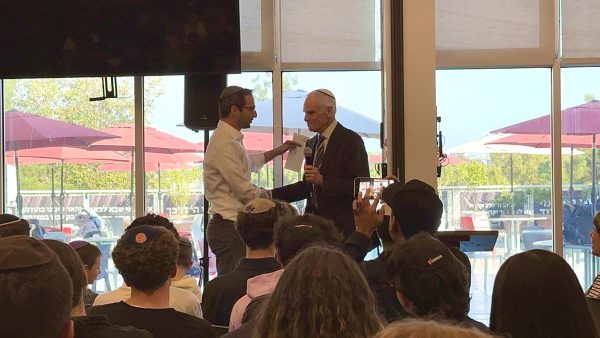EDITORIAL: Stay open, stay home
TURNOUT: Seniors Joey Blumofe and Ean Fish were among three seniors who attended in-person school on Monday, Jan. 11.
January 23, 2021
 Three seniors, nine juniors and seven sophomores attended their grades’ classes on campus for at least part of the day Jan. 11-14, the last week of fall semester. The number of freshmen was higher, but as with the lower grades, many students left once their Judaic (in-person) classes were over.
Three seniors, nine juniors and seven sophomores attended their grades’ classes on campus for at least part of the day Jan. 11-14, the last week of fall semester. The number of freshmen was higher, but as with the lower grades, many students left once their Judaic (in-person) classes were over.
The remaining students decided on their own and simultaneously not to attend in-person learning at this time.
The reasons are clear. With LA County being in the Covid-19 “purple” tier and an average of 10,000 new coronavirus cases each day, it seems like added stress to go to school and worry afterwards about whether or not you may have contracted coronavirus. While this is a decline from the average 15,000 new cases per day as of Jan. 14, the more infectious new variant from Britain has now been found in our county, and Department of Public Health director Dr. Barbara Ferrer asked (though did not require) schools to re-close.
And aside from the health risks, what’s the point in going to school when none of your friends are going?
Shalhevet reopened Dec. 1 for in-person learning, except for AGS and some co-curriculars, which had been meeting before and after school. Administration mentioned at the time that it was important for the school to start so that Shalhevet would not face the possibility of school never taking place outside of Zoom.
The Boiling Point Editorial Board believes it makes sense for Shalhevet to remain open. Shalhevet’s Medical Task Force approves and tracks the schools in-person learning. The original lawsuit filed by religious schools to reopen in person, was won, called Samuel A. Fryer Yavneh Academy v. Gavin Newsom. And student’s have the ability to exercise their free will and decide whether or not to attend in person school.
But it also believed that students should not attend school — for the time being, or until the number of cases in Los Angeles drastically decreases. In other words, the school should remain open, so that once the percentage of cases decreases, students can trickle back in at the pace that feels comfortable for each student or family. This can therefore prevent what the school was worried about — the possibility of not going back until next fall — and also empowers students to think for themselves about when it feels safe to go back.
At the moment, only a handful of students are choosing to attend school, decreasing the risk of any outbreak taking place at school due to the low rate of students attending in the first place. And until the number of cases decreases citywide, this seems to be best for staying safe in a county with citizens at a high risk of contracting coronavirus.
For now, most students should not attend school, however, the school should remain open. If the percentage of cases in the county decreases, students will gradually be able to go back without a sense of fear — and it will be there, open and waiting.
















